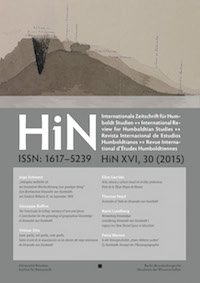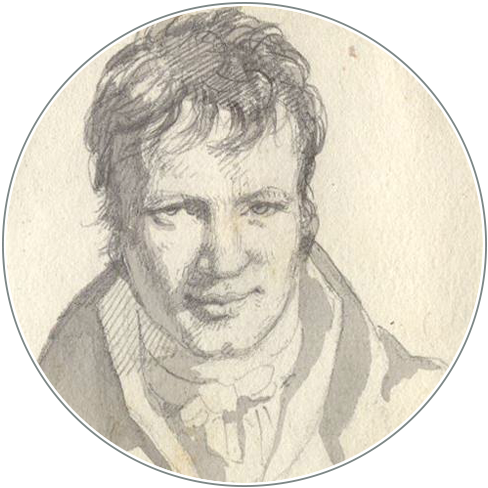Icono-grafía, cali-grafía, auto-grafía. Sobre el arte de la visualización en los diarios del viaje americano de Alexander von Humboldt
DOI:
https://doi.org/10.18443/213Keywords:
Amerikanische Reisetagebücher, Handschriften, Humboldtian Science, Ikonographie, SchriftbildlichkeitAbstract
Summary
In the paintings showing the late Alexander von Humboldt, there are figuratively condensed signs of his scientific achievements. Thus the image of the Chimborazo Humboldt did not climb to the top evokes the epistemological function of incompleteness in his work, while map, globe, and the characteristic body posture refer to the central value of motion and of a way of „writing face to face with the objects“. The presence of writing materials in the paintings is striking which may be understood as an indication to the lifelong importance of the American Travel Diaries. They in turn represent the central themes of the Humboldtian Science. The characterization of work in progress and the consistent relational dimension of the representation indicate the epistemological constants of this science just as well as the dimension of corporality which emerges recognizably from the handwriting.
Zusammenfassung
In Gemälden, die den späten Alexander von Humboldt zeigen, finden sich bildlich verdichtete Zeichen seines wissenschaftlichen Lebens. So erinnert das Bild des von Humboldt nicht ganz bestiegenen Chimborazo an die epistemische Funktion des Unabgeschlossenen in seiner Arbeit, während Karte, Globus und die charakteristische Körperhaltung auf die zentrale Bedeutung der Bewegung und auf das „Schreiben im Angesicht der Dinge“ verweisen. Auffällig ist die Präsenz des Schreibmaterials in den Bildern, das als Verweis auf die lebenslange Bedeutung der Amerikanischen Reisetagebücher verstanden werden kann. In diesen kommen wiederum die zentralen Momente der Humboldtian Science zum Ausdruck. Der Charakter des work in progress und die konsequente Relationalität der Darstellung zeigen die epistemologischen Konstanten dieser Wissenschaft genauso an wie die in der Handschrift erkennbare Dimension der Körper-Leiblichkeit.
Resumen
En las pinturas que retratan al erúdito Alexander von Humboldt encontramos densos signos visuales las cuales simbolizan su vida científica. La imagen del Chimborazo, cuya cima Humboldt no había alcanzado, recuerda la función epistémica de lo inacabado en su obra, mientras que la carta, el globo y su postura típica remiten al central significado del movimiento y al “escribir de cara a las cosas”. La presencia de sus objetos de escritura en las imagenes llama la atención, ya que se puede entender como referencia al significado de los diarios del viaje americano escritos durante toda la vida. En aquellos se ponen de manifiesto los momentos centrales del Humboldtian Science. El carácter del work in progress y la relacionalidad consecuente de la representación muestran las constantes epistemológicas de esta ciencia así como la dimensión de lo corporal en los manuscritos.
How to Cite
Issue
Section
License
Copyright (c) 2015 Ottmar Ette

This work is licensed under a Creative Commons Attribution-NonCommercial 4.0 International License.
HiN operates under a Creative Commons-Licence (CC BY-NC 4.0), which permits the reproduction of articles, free of charge, for non-commercial use only and with the appropriate citation information. All authors publishing with HiN accept these terms of publication.
Authors retain the copyright for their articles and reviews. Copyright of the layout and design of HiN articles remains with the journal and cannot be used in other publications.










